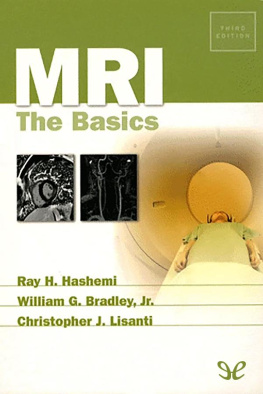PART I
Basic Concepts
PART II
Fast Scanning
Appendix C
Abbreviations
, ,
Alpha, theta, phi. Symbols used to designate an angle (e.g., flip angle)
. Gyromagnetic ratio (in T/ MHz )
. Micron (10-6 m)
. Standard deviation
. Symbol used to designate time
, 0
Omega. Angular (Larmor) frequency (in radians/sec)
2D
Two dimensional
2DFT
Two-dimensional Fourier transform
3D
Three dimensional
3DFT
Three-dimensional Fourier transform
A2D, ADC
Analog-to-digital converter or conversion
ASSET
Array spatial and sensitivity encoding technique
B0
Main external magnetic field
B1
Magnetic field associated with the RF pulse
b-FFE
balanced fast field echo
b-SSFP
balanced steady-state free precession
BW
Bandwidth
CNR
Contrast-to-noise ratio
CSE
Conventional spin echo
DE
Driven equilibrium
EPI
Echo planar imaging
ESP
Echo spacing
ET
Echo train
ETL
Echo train length
FC
Flow compensation
FFE
fast field echo
FFT
Fast Fourier transform
FGR
Fast GRASS
FID
Free induction decay
FIESTA
Fast imaging employing steady-state acquisition
FISP
Fast imaging with steady-state precession
FLAIR
Fluid-attenuated inversion recovery
FLASH
Fast low-angle shot
FOV
Field of view
FSE
Fast spin echo
FSPGR
Fast SPGR
FT
Fourier transform
Gx
Frequency-encoding gradient
Gy
Phase-encoding gradient
Gz
Slice-select gradient
GE
Gradient echo
GM
Gray matter
GMN
Gradient moment nulling
GMR
Gradient-motion rephasing
GRASE
Gradient and spin echo
GRASS
Gradient recalled acquisition in the steady state
GRE
Gradient echo or gradient-recalled echo
HASTE
Half-Fourier acquired single-shot turbo spin echo, Siemens
Hz
Hertz (1 cycle/sec)
IPAT
Integrated parallel acquisition techniques
IR
Inversion recovery
kHz
Kilohertz
M0
Initial longitudinal magnetization
MAST
Motion artifact suppression technique
MEMP
Multi-echo multiplanar
MHz
Megahertz
mm
Millimeter (10-3 m)
MOTSA
Multiple overlapping thin-slab acquisition
MPGR
Multiplanar GRASS
MP-RAGE
Magnetization-prepared, rapid acquisition gradient echo
MR
Magnetic resonance
MRA
Magnetic resonance angiography
MRI
Magnetic resonance imaging
msec
Milliseconds
MT
Magnetization transfer
MTC
Magnetization transfer contrast
Mxy
Transverse magnetization in the x-y plane
Mz
Longitudinal magnetization
NEX
Number of excitations
nm
Nanometer (10-9 m)
NMR
Nuclear magnetic resonance
NPW
No phase wrap
NFW
No frequency wrap
NSA
Number of signal averages
Nx
Number of frequency-encoding steps in the x direction
Ny
Number of phase-encoding steps in the y direction
Nz
Number of phase-encoding steps in slice-select direction (in 3D imaging)
PC
Phase contrast
PD
Proton density
PDW
Proton density weighting
PDWI
Proton density-weighted image
pixel
Picture element
POMP
Phase offset multiplanar
pm
Picometer (10-12 m)
ppm
Parts per million
PS
Pulse sequence
PSD
Pulse sequence diagram
PSIF
Opposite of FISP
RARE
Rapid acquisition with relaxation enhancement
Re
Reynolds number
RF
Radio frequency
SE
Spin echo
SENSE
Sensitivity encoding
SMASH
Simultaneous acquisition of spatial harmonics
SNR, S/N
Signal-to-noise ratio
SPGR
Spoiled GRASS
SSFP
Steady-state free precession
SSFSE
Single-shot fast spin echo, GE
STIR
Short TI (or tau) inversion recovery
T1
T1 relaxation time, longitudinal relaxation time, and spin-lattice relaxation time
T1W
T1 weighting, T1 weighted
T1WI
T1 -weighted image
T2
T2 relaxation time, transverse relaxation time, and spin-spin relaxation time
T2*
T2* relaxation time
T2W
T2 weighting, T2 weighted
T2WI
T2 -weighted image
T2*W
T2* weighting, T2* weighted
T2*WI
T2* -weighted image
T
Tesla; period of a periodic signal
TE
Echo delay time (time to echo)
TI
Time to inversion (inversion time)
T0
Overhead (dead) time in the pulse cycle
TOF
Time of flight
TONE
Tilted optimized nonsaturating excitation
TR
Repetition time (time of repetition)
tR
Rise time
Ts
Sampling time
TSE
Turbo spin echo
Turbo
Siemens' and Philips' prefix to denote a fast scanning mode
VB
Variable bandwidth
VENC
Velocity encoding
VEMP
Variable echo multiplanar
voxel
Volume element
WM
White matter
Acknowledgments
We would like to thank Robert Mulkern (Brigham and Women's Hospital) for helpful comments on the equations in Chapter 17. This generated an e-mail debate on the formula for signal-to-noise, which went on for a month and included MR giants such as Mark Haacke (Wayne State), John Mugler (UVa), Felix Wehrli (Penn), Gary Fullerton (UColo), and Mark Bydder (UCSD Graeme's son and future giant).
Appendix B
Answers
Chapter 1
1-1 (a) See Figure 1-17
(b) See Figure 1-18
1-2 ei(x+y) = eixeiy. So cos (x + y) + isin (x + y) = (cos x + isin x)(cos y + isin y) = (cos x cos y sin x sin y) + i(cos x sin i + sin x cos y)
1-3 sinc(0) = sin(0)/0 = limd/dx (sin x/x) xrarr;0
= cosx/1 = cos0/1 = 1/1 = 1 (x = 0)











